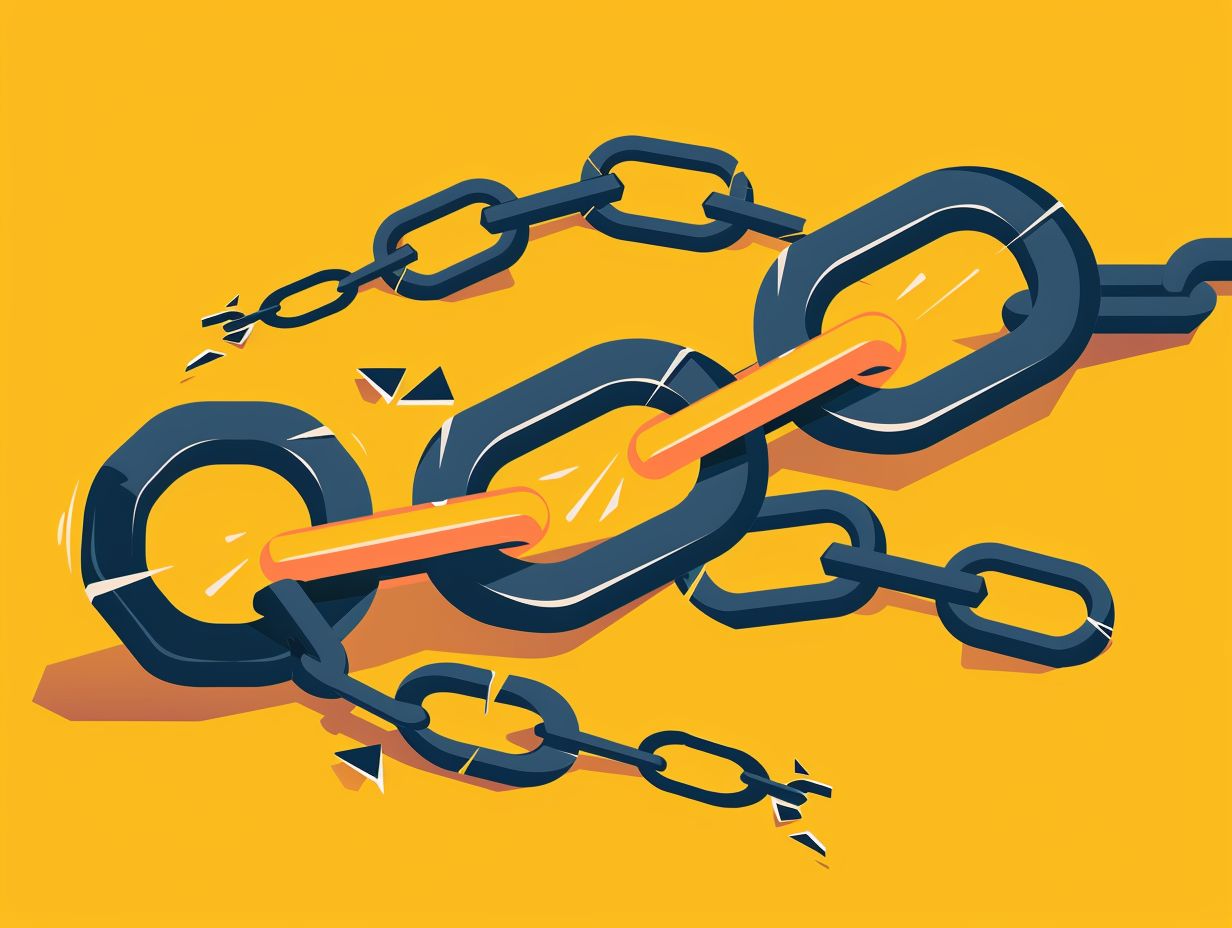In the world of SEO, understanding different types of links is crucial for enhancing a website’s visibility in search engine results.
One key term in this context is “NoFollow.” But what exactly does NoFollow mean, and how does it differ from a DoFollow link?
This article explores the implications of NoFollow links, their significance in SEO, and how to strategically use them to improve visibility.
Learn how streamlined content creation can effortlessly produce SEO-optimized articles.
Contents
Key Takeaways:

What Is a NoFollow Link?
The NoFollow link is an HTML attribute that instructs search engines not to follow the link or pass any PageRank value to the linked page. Although the link can still offer traffic and visibility benefits to the website, it is typically used when the website owner does not wish to contribute to the authority or search engine ranking of the linked site, as a traditional dofollow link would.
Why Are Links Important for SEO?
Links play a fundamental role in SEO and offer numerous benefits, including helping search engines like Google discover and index content, building a website’s authority, and driving traffic. Quality backlinks signal to search engines that a website is a respected authority, which contributes to improved search rankings and increased visibility. The more authoritative and relevant the backlinks, the higher the perceived reputation of the website.
Both internal and external links are essential for SEO optimization on eCommerce platforms. Internal links assist users in navigating products and related content in an organized manner. They also help distribute PageRank (or link juice) among various pages, ensuring that more important pages achieve greater visibility.
While less common, external links can significantly enhance a website’s credibility and trustworthiness according to Google’s guidelines. When external links are strategically placed and contextual, they provide valuable information that supports the content available on a website. By using links strategically, websites can boost their referral traffic and establish a strong online presence.
How Does a NoFollow Link Work?
A NoFollow link refers to the use of a specific HTML attribute (rel=”nofollow”) applied to a link, instructing search engines not to follow the link or pass any link equity to the target page. This practice is beneficial for controlling the flow of link authority and clarifying which links are endorsed by the website owner.
By strategically using NoFollow links, website owners can effectively manage their site’s SEO profile while minimizing the risk of penalties associated with spammy links.
What Is the Difference Between a NoFollow and DoFollow Link?
The primary difference between NoFollow and DoFollow links lies in their impact on SEO and link equity. A DoFollow link allows search engines to follow the link and pass PageRank to the linked page, thereby enhancing its authority and potential search ranking.
In contrast, a NoFollow link does not transfer link equity; while it may generate traffic, it does not contribute positively to the SEO performance of the linked page. This distinction is crucial for optimizing link-building strategies.
According to Google’s policies, DoFollow links play a vital role in shaping a website’s link profile, which is a significant factor in how search algorithms operate. Essentially, DoFollow links signal to search engines that the content being linked to is valuable and trustworthy.
On the other hand, NoFollow links are designed to prevent spam and manipulative practices on the web. Striking the right balance between these two types of links can lead to stronger SEO outcomes, as both serve important and distinct roles in enhancing online visibility and credibility.
Why Are NoFollow Links Used?
NoFollow links serve various purposes in SEO, with one of the primary reasons being the control of link equity flow and the avoidance of potential penalties from search engines.
These links are especially beneficial for scenarios involving paid links, user-generated content, sponsored content, and forum comments. In these situations, the website owner may not want to endorse the linked sites or be perceived as participating in a link scheme.
1. Paid Links
Paid links are designated as NoFollow to comply with Google’s policies and avoid penalties associated with paid link schemes. Businesses utilize the NoFollow attribute to promote their content without adversely impacting their SEO and to maintain transparency regarding their advertising practices.
This attribute helps protect a company’s online reputation and fosters trust with their audience, who values this approach to advertising. While paid placements may initially drive traffic, violating SEO guidelines can lead to significant consequences from Google, such as lower search rankings.
NoFollow links offer a proactive solution, allowing companies to engage in sponsored content while minimizing risks. Ultimately, adhering to these ethical guidelines enables brands to develop a transparent marketing strategy that honors both Google’s regulations and the trust of their audience.
2. User-Generated Content
User-generated content, such as comments and forum posts, often contains NoFollow links to help control spam and maintain the quality of the website’s SEO profile. This practice ensures that the website can benefit from user insights without inadvertently promoting spammy links.
Implementing the NoFollow attribute in these contexts is essential for tackling the challenges posed by unwanted content. Quality management for website owners and forum moderators can be a difficult balancing act; they must foster an engaging community while preserving the site’s reputation.
This is particularly relevant in SEO discussions, where the quality of backlinks significantly affects a website’s search engine ranking. By moderating user-generated content, websites can mitigate the risk of harmful link-building practices while still encouraging positive user engagement.
This approach ultimately creates a more reputable platform that benefits both the audience and the site’s long-term goals.
3. Sponsored Content
Sponsored content incorporates NoFollow links because these attributes make the sponsorship clear to both users and search engines, ensuring that no link equity is passed on to the sponsored page.
This practice not only protects the sponsor and the host website but also aligns with Google’s regulations, thereby supporting the integrity of the website.
By clearly identifying these links, content creators and marketers adhere to ethical advertising standards and foster trust with their audience. Such transparency is increasingly important in the digital landscape, where users are routinely assessing the authenticity of the content.
Adhering to these guidelines helps organizations stay compliant with search engine policies, thereby minimizing the risk of penalties. Effective link management through NoFollow tags can safeguard website authority and ensure that only genuine, organic links contribute value to the target page’s ranking.
4. Comments and Forums
Links in comments and forums are often marked as NoFollow as a precautionary measure to ensure that the site does not pass on link equity to irrelevant or spammy websites, which could negatively impact SEO. This approach facilitates the free exchange of ideas while providing a protective mechanism against spam and other undesirable linking practices.
By utilizing NoFollow attributes, webmasters can maintain a healthy level of user engagement without risking their site’s reputation. This allows them to create a safe environment for user-generated content that encourages authentic discussions and meaningful comments, while also discouraging malicious attempts at backlink manipulation.
It strikes a balance that fosters a vibrant community where users feel free to share their thoughts, all while safeguarding the site’s SEO integrity from corrupt external influences. When used effectively, NoFollow links serve as a powerful tool for establishing a safe space where user engagement and site integrity are both highly valued.
How Do NoFollow Links Affect SEO?
NoFollow links can significantly influence SEO strategies, particularly concerning link equity and a website’s ranking. Although NoFollow links do not pass PageRank, they play a vital role in creating a diverse link profile, which is essential for maintaining a strong SEO presence.
However, an excessive number of NoFollow links may lead to visibility penalties, as search engines favor a balanced approach to link diversity.
1. No Link Juice
The primary characteristic of NoFollow links is that they do not pass link juice, meaning they do not enhance the authority of the linked page as DoFollow links do. Overusing NoFollow links can limit the effectiveness of link-building strategies for SEO, potentially hindering the target site’s authority and growth.
However, it is essential to recognize that NoFollow links still play a crucial role in a comprehensive SEO strategy, as they help drive traffic and increase visibility. Although they do not directly impact page ranking, their significance lies in creating a diverse link profile. Search engines perceive a mix of NoFollow and DoFollow links as more natural and trustworthy.
By employing both types of links in a balanced manner, a website can mitigate the risks associated with relying solely on DoFollow links while still enjoying the benefits of referral traffic and brand exposure.
Ultimately, achieving success requires finding the right balance to maximize overall SEO performance.
2. No Impact on Page Ranking
NoFollow links do not pass PageRank, which means they do not directly affect the search engine rankings of the linked pages. Although they are less beneficial for improving SEO performance compared to DoFollow links, they still play a crucial role in creating a healthy and diverse link profile.
When developing a varied link-building strategy, it is important to recognize that NoFollow links, while less impactful on authority than DoFollow links, contribute to the overall link diversity that search engines seek. Relying solely on DoFollow links may diminish a site’s perceived legitimacy, as a natural link profile typically includes multiple link types.
Incorporating NoFollow links can indirectly support a site’s credibility, mitigate the risk of over-optimization, and enhance its overall natural appearance. Therefore, by integrating both DoFollow and NoFollow links, one can optimize their ranking potential and better align with the requirements of search engine algorithms.
How Can You Identify a NoFollow Link?
NoFollow links can be identified by examining the HTML code or using browser extensions. In the HTML, you can recognize a NoFollow link by looking for the ‘rel=nofollow’ attribute, which instructs search engines not to follow that particular link.
Additionally, browser extensions, such as NoFollow, can help identify these links on any webpage when activated.
1. HTML Code
In HTML, a NoFollow link is designated by the attribute rel="nofollow", which instructs search engines not to follow the link or count its link equity. This rel="nofollow" attribute is included in the anchor tag of the hyperlink, making the presence of “nofollow” an essential component of effective SEO management practices.
For instance, a standard NoFollow link in HTML code can be written as <a href="https://www.example.com" rel="nofollow">Visit Example</a>.
Understanding NoFollow links is crucial for web developers and the SEO industry because they help control the flow of link juice, allowing for more precise influence over a site’s authority and relevance while avoiding the endorsement of low-quality or spammy websites.
By strategically using NoFollow links, a website can maintain its ranking integrity while still engaging in various digital marketing strategies, such as sponsored content or user-generated submissions, which may not positively impact search visibility.
2. Browser Extensions
Browser extensions that can identify NoFollow links on visited pages offer users a quick visual indication of which external links carry the NoFollow attribute. These tools are valuable for both general users and SEO professionals who need to conduct link profile audits efficiently. By utilizing these browser extensions, the efficiency of SEO audits can be significantly enhanced. Website owners and SEO specialists can more easily pinpoint which links may negatively affect their linking authority and potential rankings.
Some popular browser extensions include:
- SEOquake: This extension provides a range of link metrics and clearly indicates the NoFollow attribute.
- Link Grabber: It simplifies link analysis by displaying all links and marking their statuses for easy review.
- Check My Links: This tool helps identify broken links and clearly marks those with NoFollow attributes, assisting users in refining their linking strategies.
All of these tools contribute to improving linking strategies as part of a comprehensive SEO enhancement project.
How to Use NoFollow Links in Your SEO Strategy?
In SEO, utilizing NoFollow links can enhance link profiles by diversifying link sources and protecting against penalties associated with spammy backlinks. By using NoFollow links strategically, site owners can engage in user-generated content, sponsored content, and other contexts while still preserving a healthy site authority and reputation.
1. Diversify Your Link Profile
Balanced SEO strategies revolve around establishing diverse link profiles that include both NoFollow and DoFollow links. By incorporating a variety of links, the risks associated with relying solely on one type are minimized. A diverse link profile signals to search engines that your website is a valuable resource, thereby enhancing its authority and credibility.
Beyond boosting visibility, a varied link profile contributes to a site’s reputation over time. This can be achieved by actively pursuing NoFollow links from reputable sources, such as social media platforms and forums. These links are beneficial for driving traffic and create a more natural linking strategy.
Additionally, leveraging high-quality DoFollow links from authoritative domains can significantly enhance your site’s ranking potential. Understanding the importance of link diversity is crucial for maintaining a strong online presence, as it demonstrates to search engines the multifaceted value your site provides to users.
2. Use NoFollow Links for Paid or Sponsored Content
Using NoFollow links for paid or sponsored content is crucial for adhering to the SEO guidelines established by Google, ensuring transparency and compliance. This practice not only safeguards the integrity of your website but also mitigates the risks associated with paid link schemes.
By utilizing NoFollow attributes, businesses can signal to search engines that certain links should not influence their site’s ranking, thereby protecting their SEO profile. This approach also fosters trust with users who are increasingly discerning about the distinction between editorial content and advertisements.
For marketers, the proper incorporation of NoFollow links in sponsored content aligns with ethical guidelines while optimizing online visibility. Overall, it is a vital component of maintaining a compliant online presence, avoiding penalties, and developing a comprehensive content strategy.
3. Use NoFollow Links for User-Generated Content
Incorporating NoFollow links in user-generated content is an essential strategy for minimizing spam and maintaining the integrity of a website’s link profile. By applying the NoFollow attribute to links in comments and forum posts, you can encourage community engagement while mitigating the risk of harmful external links.
This tactic not only enhances the effectiveness of a site’s SEO management but also nurtures a lively online community. To effectively implement NoFollow links, strong moderation practices are necessary to prevent spam contributions from gaining visibility.
Encouraging authentic discussions while monitoring user behavior is vital for maintaining a high-quality link profile. Establishing clear guidelines for participants fosters an atmosphere of respect in which constructive conversations can occur without jeopardizing the site’s credibility.
Additionally, utilizing CAPTCHA or similar tools can further help reduce spam, thereby improving the user experience in forums and comment sections.





